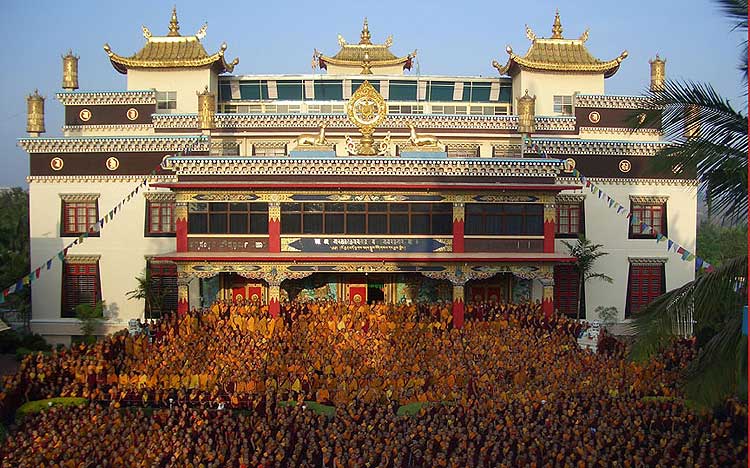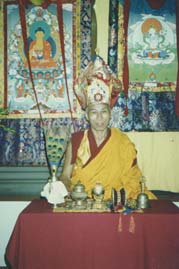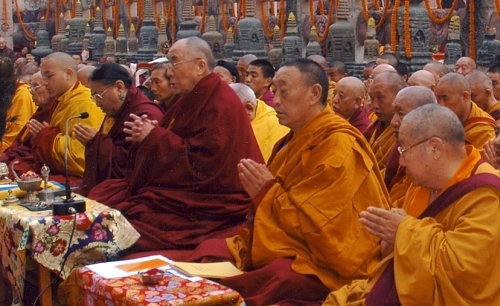 Dearest Friends @ CAS,
We are so glad to have met CAS's
precious Teacher of so many years in Singapore last week.
About Kalsang Rinpoche
Most Venerable Kalsang Yeshe
Rinpoche is one of the seniormost disciples of the late
Head of the Nyingma School, Kyabje Penor Rinpoche, having
also accompanied Him on a daring and treacherous escape from
Tibet to India during the Communist Chinese invasion in
1959.
In India, Kalsang Rinpoche assisted
HH Penor Rinpoche in the establishment of the exiled mother
monastery of the Nyingma Palyul lineage. At Penor Rinpoche's
request, HH the Dalai Lama blessed and named the newly-established
monastery, "Namdroling". Since then, the monastery has grown
to become one of the largest and most successful Nyingma establishments-communities
in the world with over 5,000 ordained sangha in Mysore,
India. Kalsang Rinpoche has served, for 16 years, as Rector
of the entire Sangha congregation of Namdroling.
 Kalsang Rinpoche is also
the sole 5 recipients of two of the most esoteric transmissions
that the late Penor Rinpoche transmitted to in secret. Rinpoche
is also a close disciple of some of the "legendary" Dzogchen
adepts of the century such as the late Nyoshul Khen Rinpoche.
Rinpoche has taken on being
the resident Teacher of Penor Rinpoche's centres in the Philippines,
Singapore and now, teaching in some of the very robust
and successful centres in Taiwan.
The interview
Out of His infinite compassion
for CAS, CAS's education centre ( Camden Education Center )
and CAS's Dharma centre in Malacca, Phuntsok Cho Ling,
this most noble of being visited and blessed Camden for
the second time, since 7 years ago, when Camden first started.
When informed of our 1,111 Friends
@ CASonline, Rinpoche spontaneously offered an one hour teaching
cum interview encompassing Dzogchen, the practice of Dharma
and so many others, in Camden, to some of the friends and
students @ CAS who were so blessed to be in the presence
of a holy and sublime being, a truest
practitioner and teacher of the Dharma, a person who has completely
given himself up for the benefit of others.
This, then, is a divine gift
from Rinpoche to all of us.
"Amituofo."
bb @ CAS ( Phuntsok Cho Ling )
/ Camden Edu Center
___________________________________________________________________________________________________________________________________
 Most Ven Kalsang Rinpoche
__________________________________________________________________________________________________________________________________
bb: There are many students
in the world who like to practise Dzogchen. Could Rinpoche tell
us how a student should proceed in the practice of Dzogchen
??
Rinpoche: There are essentially practitioners
of 3 different calibre. The practitioner of the best calibre
will realise Dzogchen. The second and third calibre practitioners
may all wish to accomplish Dzogchen but may not succeed.
bb: Why does Rinpoche say that
practitioners of the second and third calibre cannot accomplish
Dzogchen ??
R: The reason why I mentioned
that the second and third calibre practitioners may not succeed
in Dzogchen practice is because of this: these middle and lower
calibre practitioners have not established a stable and strong
foundation but directly rush into Dzogchen practice. This is
like constructing a building on flimsy ground. So, these people
are not able to accomplish Dzogchen.
bb: How does an aspiring
practitioner of Dzogchen proceed in the practice of Dzogchen
?? How does the subsequent stages proceed ??
R: All practices in sutra
and tantra begin with Refuge. For Buddhists, Refuge is the entry
gateway. After Refuge, the conscientious practitioner should
engage in the "Four Thoughts which Turn the Mind" ( Precious
Human Rebirth / Death and Impermanence / Karma / Renunciation
- sufferings of samsara ). After accomplishing Refuge and "Four
Thoughts which Turn the Mind" the practitioner should receive
the empowerment that initiates the practitioner into Dzogchen
practice.
bb: So, after Refuge then engaging
in or accomplishing "Four Thoughts which Turn the Mind", the
aspiring practitioner of Dzogchen should receive empowerments
that initiates him or her into Dzogchen practice. However,
what are these empowerments ??
R: Empowerment means the empowerments
of the Yidam practices and that of the special empowerments
of Dzogchen. There are essentailly 3 types of empowerments:
"Tro-chey" / "Tro-mey" / "Shi-de-tro-mey". Without having first
received these empowerments, one will not be able to receive
blessings of the tantra practice.
"Tro-chey" includes the
usual-standard empowerments of the vase, torma and the
like. Even after the empowerments, one should still continue
to exert in the "Four Thoughts which Turn the Mind" in order
to further reinforce stability in one's practice.
"Tro-mey" empower the practitioner
into the practice of the Wind, Drops and Channels.
"Shin-de-tro-mey" introduces
the ultimate aspect of Emptiness of all phenomena and constitutes
the actual practice itself.
So, there are these 3 graduated,
distinctive types of empowerments. Without having received
the empowerments, one will not receive the blessings.
Only through receiving the empowerments
from the accomplished Dzogchen Teacher who has mastered
all the content and all the practices, will it
then become meaningful for the aspiring Dzogchen practitioner.
The Teacher who bestows the empowerments should be knowledgeable in
all the tantric content and practice, in short, a teacher with
perfect accomplishments. It does not matter whether the teacher
is tall or short, famous or not, good-looking or not, studious
or not. When the teacher teaches, there must not be any mistakes.
The teacher must have proper practice and realisations.
The main point for receiving
the empowerments of say the Yidam practice will be to receive
the blessings of the Yidam's Body, Speech and Mind and to receive
the authority to visualise and transform one's Body, Speech
and Mind into that of the Yidam.
A lot of empowerments are bestowed
publicly these days. These are not applicable to subsequent
serious Dzogchen practice.
bb: In gist, what will Rinpoche
say about Dzogchen ??
R: The Dzogchen practices are
extremely profound; it is highly profound. With the required
qualifications, practitioners of Dzochen will receive the blessings
and accomplishments.
bb: What qualities should an
aspiring Dzogchen student possess ??
R: The aspiring practitioner
should have faith, pure motivation and strong sense of renunciation
of samsara.
We always say, "The student
who receives the empowerments should possess the greatest
devotion for the Teacher and should possess the purest of
hearts or motivation."
The Dzogchen practitioner should
possess pure heart and maintain pure commitments. Students
should also have firm faith and meditative stability. These
days, disciples have faith only when they are in a good mood.
bb: What qualities should a teacher
of the Dzogchen possess ??
R: Through compassion, the qualified
teacher teaches the methods of liberation from samsara
through the pure wish to want to benefit others. This is like
the ignition of fire of a teacher's compassion on the inflammable suitable
material of a qualified student. A mere spark shall trigger
perfect combustion.
These days, some "teachers" have
varying levels of compassion, sometimes weak, sometimes strong
or sometimes disappeared altogether. Like this, these "teachers"
cannot subdue the minds of the students. Their instability
in compassion is due to their meditative instability.
This is not to say that I have these qualities or abilities
of a perfect teacher myself !
Without meditative stability,
these "teachers" do not have clairvoyance and so cannot lead
the disciple the best way possible through selective, differentiated
teachings according to the specific dispositions of the students.
A qualified teacher can reinforce the good qualities of the
students and weaken the specific defilements of the students
as he or she knows through clairvoyance the disposition of the
student.
This is like how the Buddha taught,
through compassion and clairvoyance, teaching according
to the different calibre of the students via the different
vehicles: Hinayana, Mahayana or Vajrayana. Or if time is not
ripe, the Buddha will bless to ensure that the student meet
with a qualified Teacher some time in the future even after
His nirvana. The student may even then meet with the
Dharma say in the heavenly realms in the future when his
or her karmic link ripens due to the Buddha's blessings and
aspirations.
bb: Could Rinpoche tell us more
about the Vajrayana in general ??
R: The Buddha has taught in all
the different realms all these 3 vehicles: Hinayana, Mahayana
and Vajrayana.
Through teaching the Hinayana,
countless arahants achieved Liberation. Through Mahayana,
the countless bodhisattvas. The Buddha Himself has also taught the
Vajrayana to King Indrabhuti in the human realm.
The Buddha has prophesied that
12 years after His nirvana, the Vajrayana will spread widely through
the coming of Guru Padmasambhava. In Vajrayana, there are 3
different levels: Maha, Anu and Ati Yoga. Tro-chey, Tro-mey,
Shin-de-tro-mey empowerments corresponding to each of these
respectively.
It is wrong to think that one
does not need the foundation practices of the Hinayana and Mahayana
of the Sutra Vehicle if one is engaged in the Vajrayana. The
6 Perfections as taught in the Mahayana and Dzogchen as
taught in the Vajrayana are to be practised together.
On the other hand, Hinayana and Mahayana
teachings are actually all also included within the
Vajrayana practices.
There is no contradiction in
sutra and tantra teachings or practices. These are simply different
content-in-teaching to suit the different levels of students.
Ati Yoga or Dzogchen, Awareness
or Primordial Wisdom as taught in the Vajrayana, Tathagata
Garbha as taught in the Sutrayana: these are all different names
pointing to the same goal. The difference lies in their elaboration
and methods for achievement.
In gist, with Awareness,
one is Buddha; with Non-Awareness, one is sentient being.
bb: Could Rinpoche teach us
in brief the complete steps to adopt to practise the Dharma
??
R: The practitioner should
start with (1) Refuge as the entry point. After Refuge, (2)
internalise "Four Thoughts that Turn the Mind". ( Precious
human rebirth / Death and Impermanence / Karma / Renunciation
through understanding the sufferings of samsara ). After this,
one generates (3) Bodhicitta. With Bodhicitta, the practitioner
engages in (4) the 6 Perfections. The main point of Mahayana
is to possess Bodhicitta with the 6 Perfections as the application
aspect. Basing upon the 6 Perfections, and after the requisite
empowerments from a qualified teacher, the practitioner practises
his or her (5) Yidam, then engages in (6) practices of the
Winds, Drops and Channels and finally, (7) Dzogchen to realise
Primordial Wisdom. Throughout, the practitioner keeps the
commitments.
These are the main points of
practice in sutra and tantra. The details are in the 84,000
teachings given by the Buddha.
The teachers who taught me are
realised masters and I have learnt the salient points but
without extensive study.
bb: In what manner or how should
one practise all the above ??
R: One should, as a preliminary,
have proper conduct and motivation and then to learn the Dharma
through "Listening, Contemplating and Practising".
Through "Listening, Contemplating
and Practising" the Dharma, one should not have any doubts
but should have perfect confidence in the Dharma which one
has learnt. In society, these days, not everyone has firm
or complete confidence in what one is learning.
After having fully mastered
correctly what has been learnt, one should practically apply
what one has learnt through meditation.
Then, one will no longer need
to have doubts or worries about whether one has received blessings
of the Dharma. It is definite that one will have then received
blessings of the Dharma.
bb: Rinpoche, how do we benefit
others ??
R: The first step is proper
motivation and conduct; in general, a person's heart, a kind
heart. The second step is to possess a compassionate heart.
After firmly establishing a compassionate heart, the third
step is that one then acts for the benefit of all sentient
beings.
If one progresses in this manner,
there will be stability and of benefit to others.
Through perfecting compassion,
one benefits oneself. After firmly establishing compasson
in one's mind, one can then be of benefit to students and
sentient beings. In this way, there are dual benefit to oneself
and others.
bb: What advice will Rinpoche
want to offer to Students & Friends @ CAS ??
R: I have already mentioned
in relative detail earlier on. The main point is that the
teachers and students in CAS in Singapore, Phuntsok Cho Ling
( CAS ) in Malaysia and CAS's education centre - Camden Education
Center, should have proper motivation and conduct. They should
have the purest hearts possible and try to achieve the best
standards in teaching and learning.
What is conduct? In a country,
there are laws. In the Buddhist centres, there are the stipulated
commitments defining skilful or unskilful behaviour.
When learning the Dharma, one
should have devotion. When speaking, one should have courtesy
and respect. All these are the basics in Dharma practice.
In fact, I do not need to mention these even as Buddhists
are simply expected to be like this. I am merely offering
a reminder here !
In gist, we need to possess
purity in Body, Speech and Mind. Body, Speech and Mind are
reflections of our conduct and motivation. With these "basics",
we teach the students well.
bb: What advice will Rinpoche
want to give to the teachers in Camden Education Center ??
R: I am very happy to be back
at CAS's education centre here in Singapore. ( CAS's education
centre - Camden Education Center: www.camden.edu.sg
). The last time I came to Camden Education Center was 7 years
ago. I am very happy to see that the centre is doing well.
The teachers here should possess
the proper motivation and conduct. These factors are very
important to the centre. Teachers need a compassionate heart
and also to firmly abide within the compassionate heart. We
should think of compassion to all sentient beings and students.
Like this, we can be of benefit to them.
First of all, in education,
there must be proper motivation and conduct, After these,
the teacher should have compassion. Through compassion, to
educate and teach. When the compassion has been firmly abided,
one can then benefit or act for the benefit of the students
and others through teaching, education and activities.
Paltrul Rinpoche especially
teaches that, for the beginning teacher, he or she should
first establish the proper motivation and conduct, then to
teach students through compassion, then to enact activities
through compassion for the good of all sentient beings. These
3 graduated steps are taught clearly by Paltrul Rinpoche.
bb: Is there anything else which
Rinpoche will like to tell us ??
R: We are all students of the
Buddha, so we should not judge and attribute our own perceptions
upon different teachers, saying this teacher teaches well but
that one does not.
bb: CAS hosts only some of the
most qualified teachers such as the Loseling Khensur Rinpoche,
HH the 100th Ganden Trisur Rinpoche, the Kathok Getse and
other such eminent teachers and we pray to be able to organise
a proper Dharma programme for Rinpoche in the future. We pray
that Rinpoche's holy feet could touch CAS's first Dharma centre
in Malaysia which the late Head of the Nyingma Tradition, Kyabje
Trulshig Rinpoche, has named "Phuntsok Cho Ling".
R: This is good. If students
have faith, they will receive the blessings. I also have the
wish to offer Dharma teachings in CAS's Dharma centre, Phuntsok
Cho Ling.
bb: Rinpoche, you are our closest teacher
in the Palyul Nyingma tradition. HH Penor Rinpoche has
told us that there is no difference between Himself
and you.
( Rinpoche smiled and kept quiet.
)
_________________________________________________________________________________________________________________________________
Holy Pics:
Tara Lama - the Head of Tantra
( "Dorje Lopon" ) of Namdroling Monastery; whose very being
emanates such deep blessings and compassion, physically
resembling so much the late Penor Rinpoche.
The great Palyul tulkus:
Kalsang and Samten Rinpoches.
 His Holiness the Dalai
Lama flanked to His sides the respective heads of the Tibetan
spiritual lineages: the 102nd Ganden Tripa ( Head of the Gelugpa
School ) / the Gyalwa Karmapa ( Head of the Kamtshang Kagyu
School ) / the Sakya Trizin ( Head of the Sakya School
) / the Menri Trizin ( Head of the Bon Tradition ) /
Kyabje Penor Rinpoche ( Head of the Nyingma School ).
___________________________________________________________________________________________________________________
tELL
A fRIEND
"KNOW
DHARMA; SHARE DHARMA !!"
Be
part of our thousand++
"Friends @ CAS"
( that belongs to Chenrezig & other holy beings ) xxxxxxxxxxxxxxxxxxxxxxxxxxxxxxxxxxxxxxxxxxxxxxxxxxxxxxxxxxxxxxxxxxxxxxxxxxxxxxxxxxx
"I
wanna number my days in samsara. sUBSCRIBE mE NOW
!!"
Email
contact@casotac.com
See
www.casotac.com
( available 24 hrs a day / 7 days a week )
CASonline
- Your Buddhist online news and teachings. ( All online articles lovingly archived at http://www.casotac.com/casonline.htm ) |